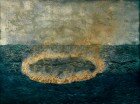Holy water: Witt plumbs the depths
In Color: A Natural History of the Palette, author Victoria Finlay discusses an unfinished figure in Michelangelo's 1501 painting, "The Entombment." Historians speculate Michelangelo intended it to be the Virgin Mary but that he probably lacked funds to buy the ultramarine pigment necessary to paint her robes. After all, then as today, this particular shade of blue derives from ground lapis lazuli, mined almost exclusively in the northern hills of Afghanistan.
Nearly every aspect of this story–- the preciousness of the material, its Afghan source, and its sacral use–- relates to Clay Witt's current exhibition, "Ultra Marine," currently on view at Les Yeux du Monde. The show is well named since not only does Witt make lavish use of lapis lazuli most of the four large and four small works on display, but he also shifts his focus from land to sea for this series.
Known for combining unusual media, ranging from cut Japanese paper to gold leaf and rust, Witt creates complexly layered paintings that center on archetypal religious symbols. His technique often yields a sense that his work is from another era, perhaps excavated from an archeological site (case in point, "St. Otto"). Yet Witt's paintings contain allegorical references to modern issues, such as the situation in Afghanistan and the oil spill in the Gulf of Mexico.
In "Leviathan," named for the Biblical monster of the deep, a ring of fire burns in the middle of a roiling sea. Its stylized flames, created in bas-relief with gold leaf, call to mind Buddhist iconography. Witt skillfully uses cut paper to suggest forth on the churning waves, under- and overlaying it with pigments and polymers that shift from shadowy ultramarine and azure in the foreground to pale turquoise and teal near the horizon. Particularly impressive is how Witt conveys translucent steam and smoke drifting on the breeze into a mottled grey sky.
It's easy to get lost in looking at Witt's work; the poetic depth of the images resonates with viewers at a primal level while the artistry of his technique mesmerizes. "Exodus at the Edge of the World" is especially riveting, as sea life and silvery stars from the night sky plunge downward into a black hole-like vortex in the middle of an inky ocean.
With their religious references and opulent materials, Witt's paintings call to mind a different time, when spiritual concerns were worthy of material wealth.
Clay Witt's exhibition, "Ultra Marine," is on show through January 2 at Les Yeux du Monde. Witt will give a gallery talk on Sunday, December 5, at 3pm. 841 Wolf Trap Road. 973-5566.
